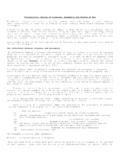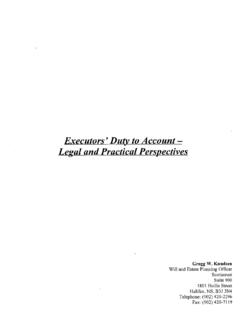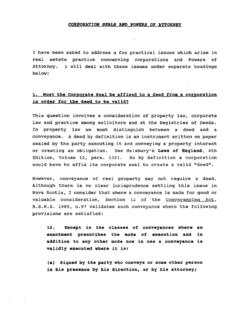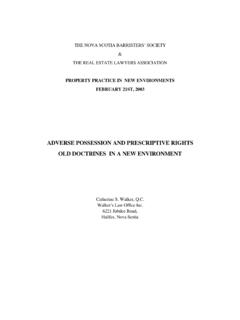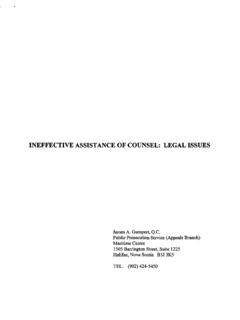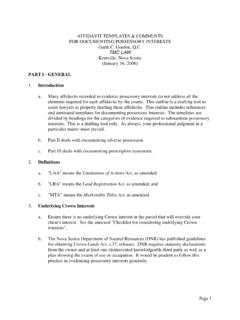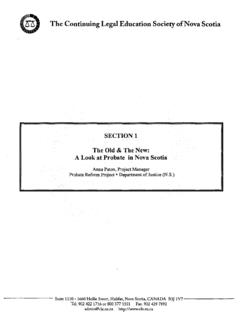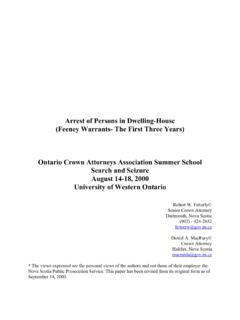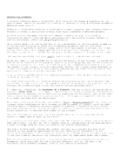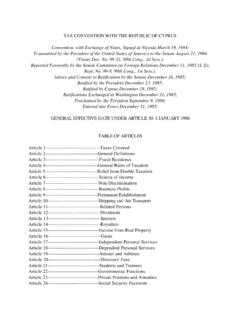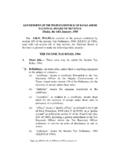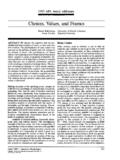Transcription of RESTRICTIVE COVENANTS - NSBS Home
1 RESTRICTIVE COVENANTSA covenant affecting land is RESTRICTIVE if it restricts the doing of something to, on,over or under land or in relation to an estate or interest in land: Elphinstone -CovenantsAffecting Land, page , a RESTRICTIVE covenant is contained in a deed conveying land, although there isnothing to prevent a RESTRICTIVE covenant from being created by a separate first glance, one might ask why this subject is being included in a course on"Practical Property", since the above description of a RESTRICTIVE covenant appears torest on contractual rather than property A conveys land to B, and in the deed B, in consideration of the conveyance, agrees notto use the land for purposes other than residential purposes.
2 Does not the usualrequirement of privity of contract apply, and if this requirement is not met, can it notbe said that A only has a remedy against B if B breaches this covenant , unless there is avoluntary assumption of liability for its breach by B's successors in title to the land?This was the case until 1848 when Tulk v. Moxha (1848), 41 was that time, it was possible for A, who had the benefit of the covenant , to assign thebenefit of the covenant to the purchaser when he sold the property, but, in the absence ofa voluntary assumption of liability on the covenant by subsequent purchasers of the landthe benefit of the covenant would be practically useless, the covenant being designed, asit was, to enhance the value of the property retained by A by restricting the use of theneighbouring property originally conveyed to D.
3 J. Donahue pointed out in his book the Conveyancer's Guide to Real Estate Practicein Ontario, at pages 72-73,"A RESTRICTIVE covenant is a contract between two neighbouring land owners by which thecovenantee, anxious to maintain the saleable value of his property, acquires the right torestrain the covenantor from putting his land to certain specified uses."At common law, therefore, the purchaser of a property, the use of which was restricted bycovenant, could, with full knowledge of the covenant , purchase the property and ignore therestriction, and nevertheless be free from all liability for its breach, and, by the sametoken, the person who made the covenant could sell the property in question the next dayat a profit and free from the a result, the courts of equity intervened in Tulk v.
4 Moxhay (supra). In that case, thecovenant under consideration was a covenant by the purchaser of property which includedLeicester Square to maintain Leicester Square as a garden. A successor in title to thepurchaser cleared the entire area of vegetation and the original covenantee brought anaction against him to restrain this breach of the court pointed out how inequitable the result would be if the covenantee was leftwithout a remedy when it said, at page 1144:" ..nothing could be more inequitable than that the original purchaser should be able tosell the property the next day for a greater price in consideration of the assignee beingallowed to escape from the liability which he had himself undertaken.
5 "The Court, in this case, treated the covenant not only as a contract but also as aninterest in real property appurtenant to the land owned by the covenantee, or theperson having the benefit of the covenant originally, which burdens or encumbers the titleto the land owned by the person who originally gave the undertaking under the COVENANTS which benefit land and burden other land, therefore, are akin toeasements, since there must be both a dominant tenement, that is, the land to bebenefited, and a servient tenement, that is, the land to be , in order for a RESTRICTIVE covenant to have this effect, certain conditions mustbe met.
6 These I conditions are correctly described at page 52 of Elphinstone - CovenantsAffecting Land, as follows:(a)The intention of the parties that the benefit of the covenant shouldbe capable of passing with the land to be benefited, must appear from theinstrument creating the covenant ;(b)the covenant must have the object of protecting land which, at thedate of the covenant belongs to, and after the date of the covenant , isretained by, the covenantee;(c)at the dates of the covenant and of the conveyance or assignment andat the date of the breach complained of, the covenant must be capable ofprotecting the land intended to be protected; and(d) the land intended to be protected must be described by the instrument creatingthe covenant so as to be ascertainable with reasonable certainty.
7 The covenant must also be negative in substance: Zetland v. Driver [1939] Ch. us examine each one of these characteristics more first characteristic, that is, the characteristic that the partiesintended that the benefit and burden of the covenant should be capable of passingwith the title must appear either expressly or by implication in the documentcreating the order for a covenant to have the second characteristic, that is, have theobject of protecting land, it must "touch or concern" the land. As pointed out byFarwell, J., in Rogers v. Hosegood [1900] 2 Ch.
8 388, at page 395"Adopting the definition of Bailey, J., in Congleton Corporation v. Pattison(1808), 10 East 130, 135, the covenant must either affect the land as regardsmode of occupation, or it must be such as per se, and not merely fromcollateral circumstances, affects the value of the land".Accordingly, a RESTRICTIVE covenant burdening one property must be capable of benefitinganother property. For example, a covenant that property shall be used only for residentialpurposes clearly benefits, and enhances the value of the property which is intended to bebenefited, notwithstanding who the owner of that property may is because of this principle that a covenant which is expressed to benefit lot Aby restricting the use of lot B, which may be many miles away, is probably notenforceable.
9 Thus, if A owns property in the south end of the City of Halifax and ownsanother property in the north end of the City, sells the property in the north end, andpurports to include a covenant in the deed for the benefit of the south end property tothe effect that the north end property will be used for residential purposes only, thatcovenant is clearly incapable of actually benefiting the south end property,notwithstanding what the parties intended, and is therefore only enforceable between theoriginal parties and not between the successors in title to the south end property and thenorth end next characteristic of a RESTRICTIVE convenant which runs with land, it will berecalled, is that the land intended to be protected or benefited must be described by theinstrument creating the covenant so as to be ascertainable with reasonable certainty,although a full legal description is probably not necessary if the property is otherwiseidentifiable with reasonable certainty.
10 In Re Union of London and Smith's Bank Limited[1933] Ch. 611, , a covenant which runs with land must be negative in substance. This is sobecause the remedy for a breach is injunctive in nature and the courts are reluctant togrant injunctions which require the doing of positive acts which require continuoussupervision by the courts. However, a covenant may be positive in form but negative insubstance. For example, in Tulk v. Moxhay (supra), a covenant which was positive in form,providing, as it did, that the covenantor would maintain Leicester Square as a garden, washeld to be negative in substance as actually being a covenant not to use the property forany purpose other than as a addition to meeting these general conditions, when drafting RESTRICTIVE COVENANTS , oneshould also keep in mind the following considerations.
